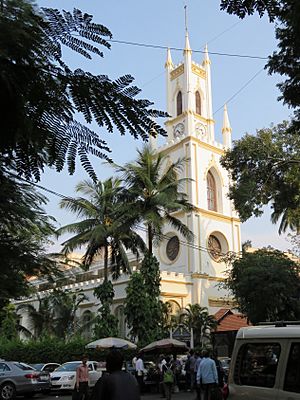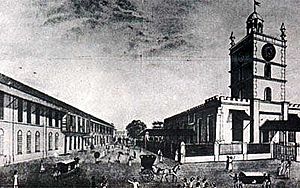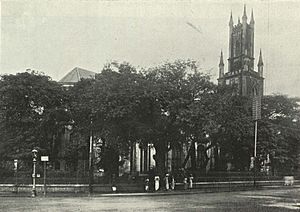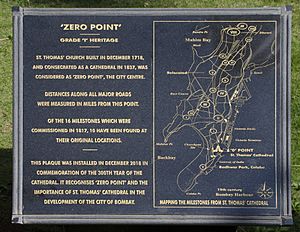St. Thomas Cathedral, Mumbai facts for kids
Quick facts for kids St Thomas Cathedral |
|
|---|---|
| Cathedral Church of St Thomas the Apostle | |
 |
|
| 18°55′54″N 72°50′1″E / 18.93167°N 72.83361°E | |
| Location | Horniman Circle, Fort, South Mumbai, Maharashtra |
| Country | India |
| Denomination | Church of North India |
| History | |
| Consecrated | 1718 & 1837 (renovation & expansion) Bombay, British India |
| Architecture | |
| Heritage designation | UNESCO Asia-Pacific Heritage Conservation Award |
| Groundbreaking | 1676 |
| Completed | 1718 1837 (Enlarged) |
| Specifications | |
| Capacity | 1200+ |
St. Thomas Cathedral in Mumbai is a very old church, over 300 years old! It's a special church called a cathedral for the Anglican Christian community in Mumbai. It's named after Saint Thomas, one of Jesus's first followers. Many people believe he was the first to bring Christianity to India.
You can find it in Horniman Circle, a historic part of Mumbai. It's near famous spots like Flora Fountain. This cathedral is the oldest church in Mumbai! It even helps run a school called The Cathedral and John Connon School.
Building the church started a long time ago, in 1676. But it took many years to finish! It was finally ready for church services on Christmas Day in 1718. This was the first Anglican church built in Mumbai (which was then called Bombay). It was inside the walls of the old British settlement.
The Churchgate railway station gets its name from St. Thomas Cathedral. This is because a road from the station led directly to the church through one of the city's old gates. The city walls were taken down in 1862. The gate near the church was replaced by the Flora Fountain in 1864.
Contents
History of St. Thomas Cathedral
The name of the nearby Churchgate Station comes from this church. One of the gates in the old fort, built by the British East India Company to protect their settlement, was the entrance to St. Thomas Church. It was called Churchgate. That's why the area west of the church is still called "Churchgate" today. The street leading to the church was first called Churchgate Street. Later, like many streets in Bombay, it was renamed Veer Nariman Road.
The island of Bombay used to belong to Portugal. It became part of England in 1661 when the Portuguese princess, Infanta Catherine of Braganza, married Charles II of England. In 1668, King Charles gave the island to the East India Company.
Gerald Aungier was in charge of the British East India Company's new places in Surat and Bombay. He was the governor of Bombay from 1672 to 1677. During this time, he built a church, a hospital, a court, and other important buildings. He also made the company's trading post stronger.
The first stone for the church was laid in 1676. It was on a place called Bombay Green, where the cathedral stands today. But it took over 40 years to finish building it! Richard Cobbe, a chaplain, completed the building between 1715 and 1718. It opened for services on Christmas Day in 1718. Since then, it has always been an Anglican place of worship. In 1816, the church was officially named after St. Thomas the Apostle. This was done by Thomas Middleton, the first Bishop of Kolkata.
The church became a cathedral in July 1837. This happened when Thomas Carr became the first Bishop of Bombay. The tall tower and the clock on the western side were added in 1838. About 25 years later, a big project started to make the chancel (the part of the church near the altar) larger. This work was finished by 1865.
In 1911, King George V and Queen Mary attended a church service here. They were on their way to a big event called the Delhi Durbar in Delhi. The chairs they sat in are still kept today, with their names written on brass plates.
A beautiful fountain stands at the entrance of the church. A kind Parsi businessman named Cowasji Jehangir Readymoney paid for it. It was designed by George Gilbert Scott and put in place in the 1870s.
Special Memorials
The cathedral has many stone memorials carved into its walls. These remember people from the time of Company rule in India and the British Raj. Here are some important ones:
- Memorial to Thomas Carr: This is a statue of Thomas Carr, the first Bishop of Bombay. It was made by a British sculptor named Matthew Noble.
- Memorial to Officers of the Ship Cleopatra: The Cleopatra was a steamship that sank off the coast of Malabar in 1847. It was carrying 100 prisoners from Bombay to Singapore. The ship had 151 crew members, including 9 officers. This memorial lists the names of the nine officers.
- Memorial to Frederick Lewis Maitland: Maitland was a Royal Navy officer. He died at sea near Bombay in 1839 and was buried in Mumbai.
- Memorial to Captain Hardinge: Captain George Nicholas Hardinge was a brave naval captain. He died in a sea battle against a French ship in 1808. His detailed memorial was made by John Bacon.
- Memorial to John Campbell: John Campbell was a British army officer. He was part of the Siege of Mangalore Fort and fought against Tippoo Sultan. He died in Bombay in 1784 from tiredness. His marble memorial shows figures of Death and Hope. It was designed by Charles Peart.
Mumbai Zero Point
The cathedral marks the "point zero" of old colonial Bombay. This was the exact center of the city. From the church, 16 milestones were placed leading north. These stones were 4 feet tall. However, they are now covered by the rising road levels. So far, 11 of the 16 milestones have been found.
St. Thomas Cathedral Today
After a big restoration project, the cathedral received a UNESCO Asia-Pacific heritage conservation award in 2004. This award recognized the excellent work done to preserve its history.
The church continues to be an active place of worship. The current leader of the church community at St. Thomas Cathedral is Rev. Avinash Rangayya.
Gallery
See also
 In Spanish: Catedral de Santo Tomás de Bombay para niños
In Spanish: Catedral de Santo Tomás de Bombay para niños









